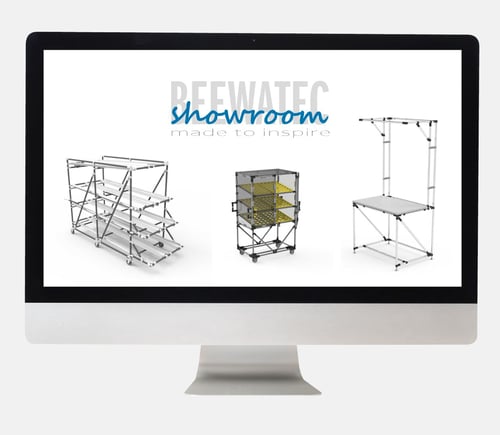6 min read
Flow rack - definition, function, examples and applications
![]() Rainer Buckenmaier
:
06.Oktober.2023
Rainer Buckenmaier
:
06.Oktober.2023
Flow racks offer an extremely efficient solution for the storage and material flow of products in a wide range of industries and applications. Their function, based on the gravity principle and the FIFO principle, enables orderly access to products and optimal use of space. This helps to reduce storage costs, increase efficiency and improve product availability, even with variants.
In this blog post, we answer all relevant questions on the topic.
Content
- What is a flow rack?
- Advantages, features and functions of a flow rack
- Types of flow racks
- Where are flow racks used?
- Planning and implementation of a flow rack
- Examples of flow racks made by BeeWaTec
- Conclusion
What is a flow rack? Definition - flow rack simply explained
A flow rack is a special racking system where products or materials are placed on inclined roller conveyors and stored in a cost-effective manner. Due to the incline and gravity, products move from the back to the front, so older products must be removed first. This principle of "first in, first out" is called the FIFO principle.
Flow racking allows for dynamic storage, easy removal of products, and time-saving order picking. This type of racking is used in warehouses, logistics centers, production facilities and other places to store products or materials and enable efficient material flow.
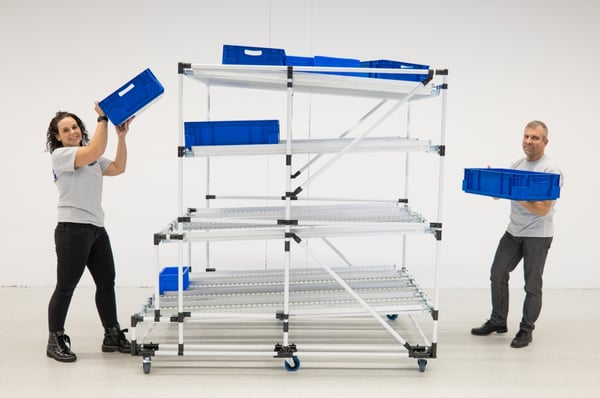
Advantages, features and functions of a flow rack
Flow racks are of great importance in various industries and warehouse environments for several important reasons:
- Improved material flow: The principle of 'First-In-First-Out' (FIFO) in flow racking ensures a continuous flow of material. Older products are removed first, which is especially important when dealing with perishable goods or batch production.
- Efficient storage: Flow racks allow high storage density and optimize space utilization. Inclined roller conveyors are loaded, wasting less space and allowing more products to be stored in a smaller area.
- Time and labor savings: Flow racks reduce the need for manual handling and searching for products in the warehouse. This saves labor costs and reduces the risk of errors.
- Better inventory control: The FIFO system and the clear arrangement of products facilitate inventory control and reduce the risk of stock loss or outdated products.
- No energy: A flow rack does not require energy for normal material flow.
- Cost reduction: Optimized space utilization, increased efficiency and reduced labor costs can result in significant cost savings.
- Adaptability: Flow racks can be customized to meet a company's specific needs and products, allowing flexibility in warehouse design.
- Cross-industry application: Flow racks find application in various industries, including food, retail, automotive, e-commerce, pharmaceutical and more.
Flow racks are especially useful for companies that handle large quantities of products and smooth material flow is critical. They help organize inventory, make the best use of space and reduce operating costs.
Discover gravity flow racks for your project
Various types of flow racks for containers, cartons, pallets & single parts
There are different types of flow rack that are used depending on the specific requirements. Here are some common types of flow rack and their typical applications:
Gravity flow rack with roller tracks
These flow racks consist of roller tracks (= channels) and are particularly useful for picking small parts and products. They are well suited for products with a relatively high throughput, such as food, beverages, consumer goods or in production.
Tip: Brake rollers help to slow down the stored goods when the angle of inclination is very steep, or there are strong height differences between the storage side and the retrieval side.
Suitable load carriers: e.g. KLT boxes, containers, cardboard boxes (different roller track types are more suitable depending on the load carrier).
Get your gravity flow rack from BeeWaTec >
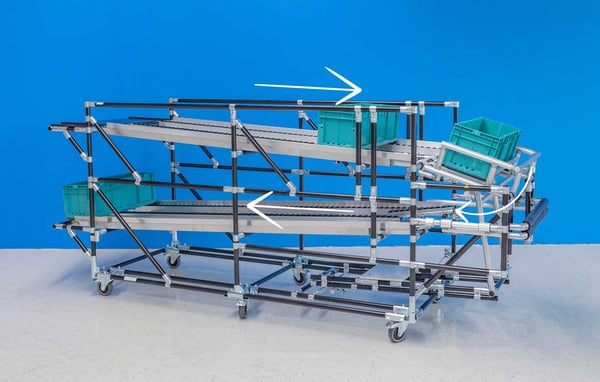
Gravity flow rack with shelves
Also by means of inclined shelves, simple rack systems can be built, where e.g. cardboard boxes slide in the storage channel (without a roller track). This type is usually only used for short distances, but can already significantly optimize storage and picking performance.
Note: The shelves need much higher inclines due to the friction effect.
Suitable load carriers: e.g. KLT boxes, containers, cardboard boxes and individual parts.
Get your gravity flow rack with shelves from BeeWaTec >
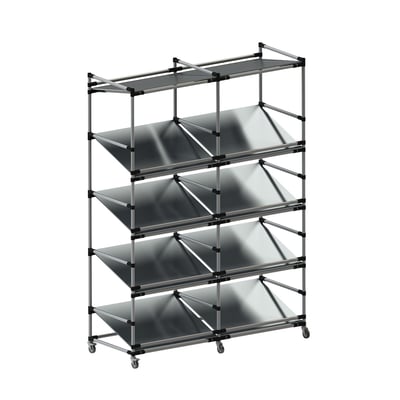
Pallet flow rack
Pallet flow racks are specially designed for pallet storage and are suitable for large, heavy products. They are often used in warehouses and production facilities where pallet materials are moved.
Suitable load carriers: e.g. pallets, grid boxes.
Push-back flow rack
In these racks, products are pushed forward with the help of a push beam. They are well suited for storage with limited space and high throughput, for example in the food industry.
Suitable load carriers: Here, the product itself is usually pushed forward (e.g. shrink-wrapped ham on supermarket shelves).
Flow rack with power elements
These racks have drive elements such as powered conveyors that automatically move products forward. They are versatile and can be found in various industries, including the automotive industry as well as logistics centers.
Suitable load carriers: e.g. pallets, mesh boxes, boxes, containers, etc. (mostly for products with higher weight / heavy loads, or for long transport distances).
Overall, there are a variety of different types of flow racks. Which one is selected depends on the following factors:
- Type of load carrier (e.g. box, carton, pallet, etc.)
- Dimensions of the load carrier
- Weight of the load carrier
- Length of the transport route
- Height difference between the rack sides for storage and retrieval
What also matters in the planning and implementation of a flow rack >
Where are flow racks used? When does a flow rack make sense?
Flow racks are used in various industries and applications. Here are some examples of flow racks:
- E-commerce warehouses: e-commerce companies use flow racks to pick orders. Products such as clothing, electronics, and household goods are placed on the inclined roller conveyors for quick access and efficient order fulfillment.
- Automotive: In automotive production, flow racks are used to store parts and components needed in the production line. This helps to keep the production process running smoothly and efficiently.
- Pharmaceutical industry: Pharmaceutical companies use flow racks to store medicines and medical products and ensure that products with limited shelf life are removed in the correct order.
- Food and beverage industry: In the food industry, flow racks are often used to store perishable products such as fresh fruits, vegetables, dairy products and beverages. The FIFO principle ensures that older products are processed first.
- Retail stores: retail stores use flow racks to display merchandise on their sales floors. This can make it easier for customers to organize and access products.
- Warehouses and logistics centers: In large warehouses and logistics centers, flow racks are used to store and distribute products and goods efficiently. This increases storage capacity and speeds up the flow of materials.
- Offices and archives: In offices and archives, flow racks are used to store files and documents. This allows for orderly storage and easy access to important documents.
- Light construction industry: In the light construction industry, flow racks are used for the storage of building materials and materials such as pipes, rods and plates.
- Textile industry: the textile industry uses flow racks to efficiently store rolls of textiles or fabrics and to allow quick material removal for production.
These examples illustrate that flow racks are used in a wide range of industries and applications to optimize storage, speed up material flow and increase efficiency.
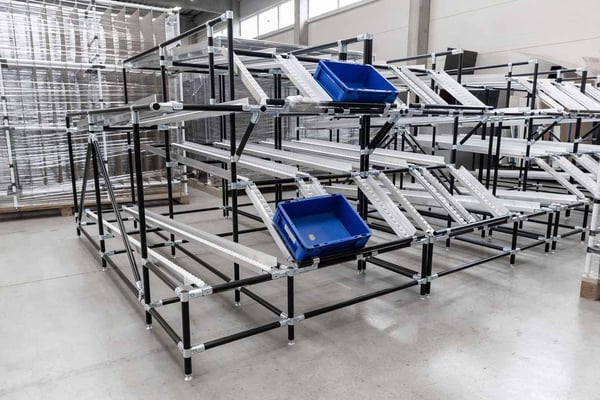
Plan and implement a flow rack in four steps
Planning and implementing a flow rack requires careful thought and steps to ensure it meets the needs of your business. Here are four steps to plan and successfully implement a flow rack:
1. Needs analysis and planning:
- First, identify your specific storage requirements and goals. What products or materials (= stored goods) should be stored? What quantity? What throughput is required?
- Determine the available space for the flow rack and consider possible structural limitations.
- Investigate the type of products or materials that will be stored and decide which flow rack type is best.
2. Design and configuration:
- Work with a professional or company that specializes in shelving systems to design the flow rack. Consider the specific requirements of your project.
- Determine how many levels or lanes the shelving should have to meet your needs.
- Determine the size of the roller conveyors or gravity conveyors and the spacing between them to ensure that your products can flow smoothly through the rack.
- Place the high-runner products at the ergonomically best reach height and the low-runner products below and above it.
3. Select materials and components:
- Select high-quality materials and components that meet the requirements of your application. This may include steel, aluminum or other materials.
- Also consider the type of rollers or conveyors that best fit your products and make sure they have a long service life.
4. Installation and commissioning:
- After the flow rack has been designed and the materials have been sourced, installation should be done by professionals to ensure that it is properly assembled.
- After installation, the rack should be thoroughly tested to ensure that the material flow works smoothly and that all safety precautions are followed.
Want to get started quickly on your own? Take advantage of our free 30-day version BEEVisio (3D software).
Examples of flow racks made by BeeWaTec
BeeWaTec is one of the leading suppliers of flexible operating equipment, including racking systems made of pipes and joints (e.g. steel or square pipes). Depending on the requirements and specifications, the storage systems are individually designed and built.
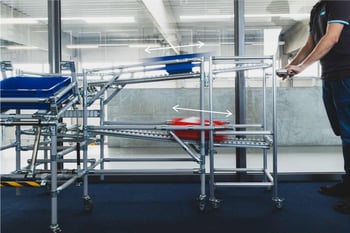
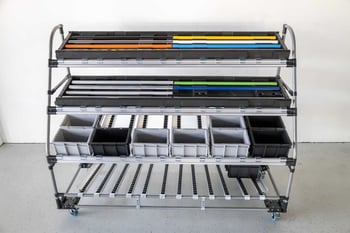
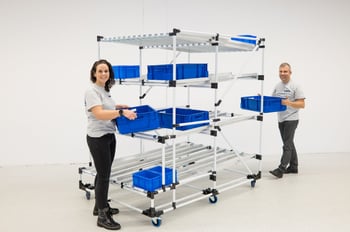
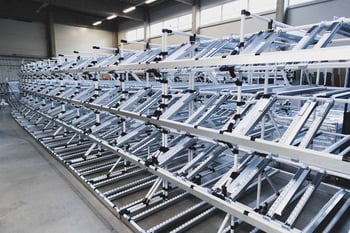
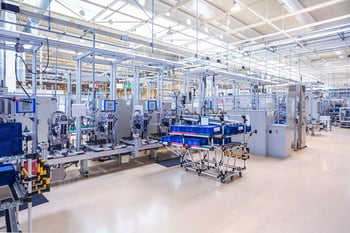
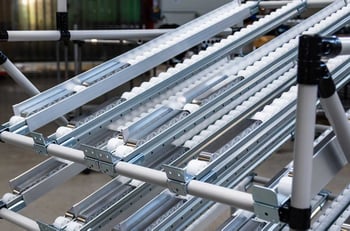
Flow racks made of pipe-racking systems also offer a variety of advantages:
- Individual planning and design based on your requirements (e.g. dimensions, number or weight of load carriers), incl. self-adaptability due to screw-based plug-in system.
- Correct choice of roller tracks, depending on the type and nature of the load carriers (e.g. plastic rollers, rubber-coated rollers, steel-coated rollers, etc.)
- (Very) high load capacities through reinforced construction or square systems - optional, depending on requirements
- Stability due to adjustable feet or castors
- Low investment costs
- Reusability of components in case of product change
Discover a variety of flow racks in our digital showroom and get inspired for your project.
Conclusion
Flow rack is an extremely efficient solution for storage and smooth material flow in a wide range of industries and applications. Its operating principle is based on gravity and the First-In-First-Out (FIFO) principle, which allows organized access to products and optimal space utilization. This helps to reduce storage costs, increase productivity and improve product availability.
Although flow racks offer many advantages, their design and implementation requires a thorough analysis of individual requirements and careful configuration. Selecting the right materials and components is critical, as is training order pickers and regular maintenance to ensure smooth operation.
Overall, flow racks are a valuable investment for companies focused on optimizing their warehouse and material flow to gain competitive advantage in an increasingly efficiency-oriented business world.
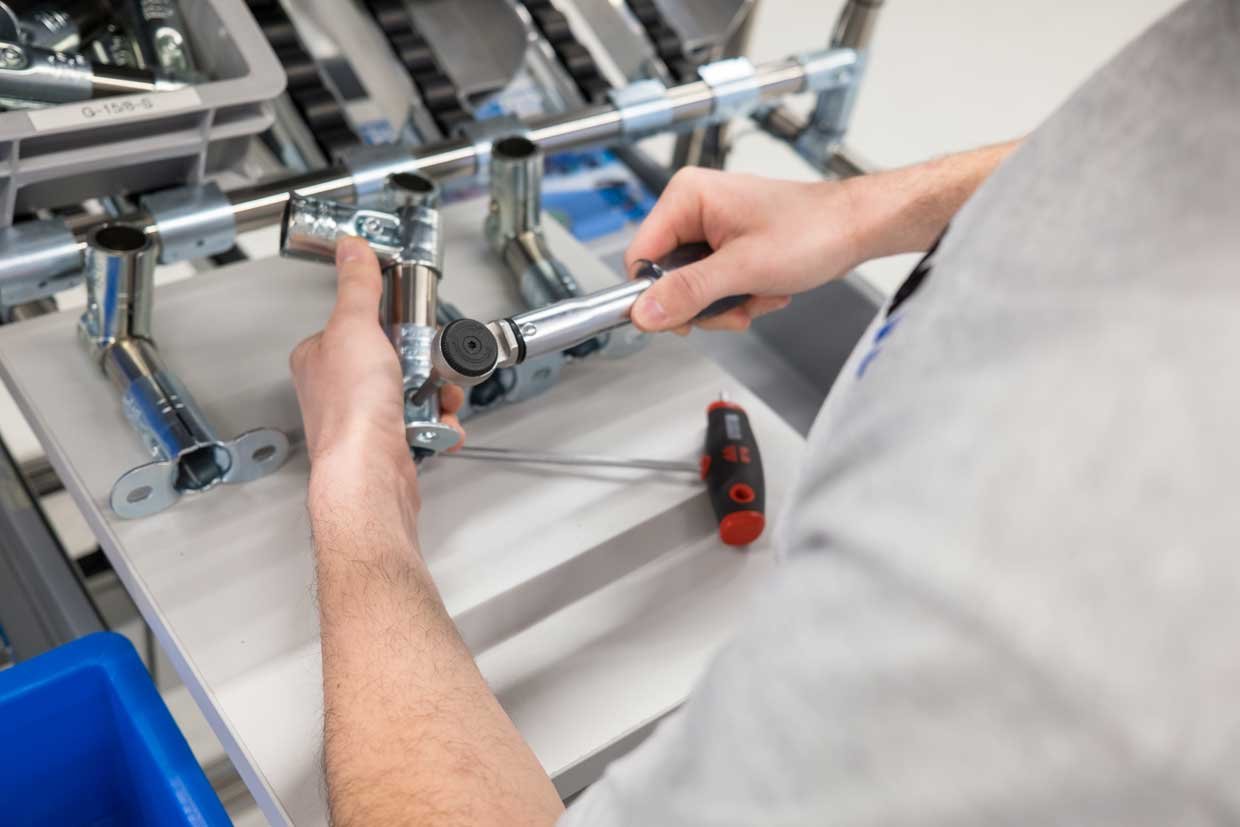


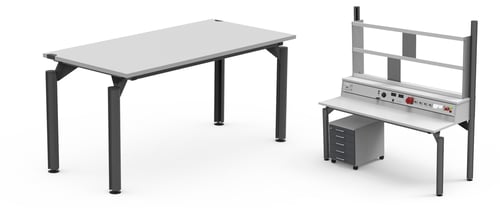
_Web_01_01.jpg?width=1240&name=Beewatec-3-(37)_Web_01_01.jpg)

